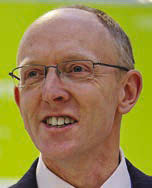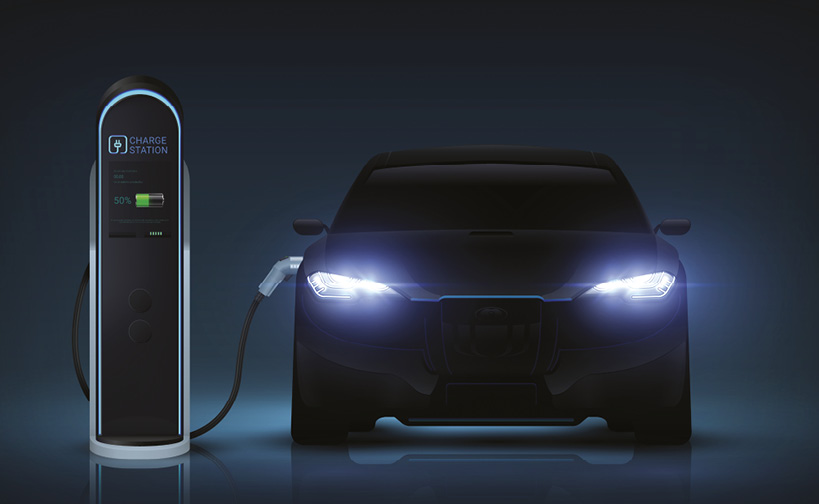FST JOURNAL
Electricity Supply
DOI: https://www.doi.org/10.53289/ACSE8402
Building the electricity grid of tomorrow
Nick Winser

Energy Systems Catapult Chair since 2015, Nick Winser CBE FREng was appointed Chair of the Advisory Board for the Energy Revolution ISCF programme in 2018 and served on the Advisory Panel for the Cost of Energy Review in 2017. He is also a member of COP26 Science Priorities Task & Finish Advisory Group and the Net Zero Expert Group which advises the Secretary of State. He is a member of the IET, serving as its President in 2017-18.
The current most likely route to decarbonising the UK energy system would probably lead to demands on the electricity grid in the order of three times as much demand as today. To address that increase using today’s structure, with more wires, transformers and substations would take decades, and cost many billions of pounds.
The existing grid was built in very different circumstances where, for example, pylons striding through the countryside were largely welcomed back in the 1960s and 70s. Attitudes have changed. Building new transmission lines, for example, to Hinkley Point nuclear power station incurs significant sanctioning and planning permissions. Therefore, this country will need an entirely different approach for the grid of the future if it is to distribute a great deal more electricity.
Currently, electricity provides in the order of 20% of end-use demand. The most likely decarbonisation routes for transport and domestic heating are likely to be via electric cars and heat pumps. Undoubtedly, other technologies will have major roles, particularly hydrogen and biofuels, but whichever way you look at, electricity demand is going to increase substantially. With biofuels, supply will be limited by land use considerations. For hydrogen, scarcity of green electricity to make green hydrogen is going to remain an issue for decades. So, decarbonisation of our existing electricity footprint will take a long time, never mind a substantial increase.
Biofuels and hydrogen are likely to be used where they really are the best solution: in aviation, industrial heat and heavy transport. Now, one technology which can take one unit of scarce precious green energy and turn it into three should create some excitement. Heat pumps are a fantastic resource in a world where green energy is going to be so short – but they do not grab people’s imagination. There is no doubt hydrogen could provide significant amounts of domestic heat, probably via industrial applications.
In a world where green electricity is either directed to heat pumps or into making green hydrogen, there will need to be a significant increase in wind farms (even with substantial encouragement to technologies like nuclear). However, for the same quantity of power, five times as many wind turbines are needed with hydrogen as with heat pumps, because electrolysis is 70% efficient while heat pumps are 300% efficient. The maths is quite easy.
The scale of this challenge for the grid requires a consideration of demand management – i.e. making it smaller – particularly by driving forward building energy efficiency. The UK is desperately overdue for a robust assessment of the potential for improving efficiency on new buildings and also on retrofits.
 Much new demand is quite different in nature from typical applications today such as being able to turn the kettle on for an instant cup of tea. Some of the new demands, such as car charging, are much more flexible in terms of when they are required.
Much new demand is quite different in nature from typical applications today such as being able to turn the kettle on for an instant cup of tea. Some of the new demands, such as car charging, are much more flexible in terms of when they are required.The grid is changing as well, from large, relatively remote (but inland) fossil fuel generation, to a blend of very remote, very large offshore wind farms and nuclear power stations, plus a plethora of small and very small, local distributed sources. Overall, the number of sources will multiply, increasing the challenge of grid coordination.
With the intermittency of renewables, what used to be an installed capacity of 60 gigawatts has risen to over 100. This is because the utilisation factor of renewables is much lower. Even when wind farms are at 30% utilisation when the wind is blowing, the grid has to be at full capacity in order to use it. So not only does the size of the challenge need to be reduced, we have to think of other solutions for the demand that remains.
Luckily, there is a variety of opportunities to help reduce the challenge. There are new technologies and new ideas to make the grid work efficiently without three times as many wires, transformers and substations.
Much new demand is quite different in nature from typical applications today such as being able to turn the kettle on for an instant cup of tea. Some of the new demands are much more flexible in terms of when they are required: car charging, for example, or heat pumps where consumption can be displaced in time with a smart energy system.
Smart energy systems will be needed to defray the large investments that are entailed. Local, distributed generation sources will also reduce intensity in grid loading. Everyone is used to a grid system that drives the flow from high voltages down to low voltages and that is where the constraints are. To address this, we will need to develop and deploy new storage technologies. Our current energy system, after all, is also based on stored energy. That is what fossil fuels are. This storage characteristic will need to be replicated.
A smart grid system powered by digital and communication technologies will optimise the grid, not from top down as has been done historically, but from the bottom up. To support this, a number of changes are needed to the management of our energy systems, including a real focus on innovation. Vigorous engagement with customers enables grid optimisation while satisfying their needs for energy in their daily lives. More granular energy markets will encourage that very detailed optimisation both in planning and operations. Local energy plans in every part of the country will help to make the most of the resources that are there.
The future electricity system will need a very different approach to building out the grid because of the new demands on it. This must be based on a changed approach to institutional architecture and the deployment of digital and communication technologies in order to balance the grid from the bottom up.
A smart grid system powered by digital and communication technologies will optimise the grid, not from top down, but from the bottom up.
